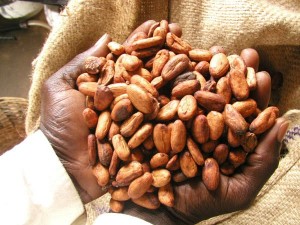Cocoa Output Seen Falling 20% on Disease, Flood
Cocoa output in Nigeria, the world’s fourth-biggest producer, is forecast to fall at least 20 percent due to disease and floods stemming from heavy rains this year, the country’s main industry group said.
“The weather changes caused considerable damage to our projected production,” Sayina Riman, president of the Cocoa Association of Nigeria, said by phone yesterday from the southwestern cocoa-trading town of Akure. There is a “high incidence of black pod disease,” he said, adding some farms were lost to landslide in Cross River state, the country’s second-biggest cocoa producing region. Black pod is a fungal disease that thrives in wet conditions.
Cocoa production is expected to be 200,000 metric tons in 2012-13. That compares with 250,000 tons the year earlier and a September forecast of 300,000 tons, according to the association, which represents farmers, traders and processors.
Nigeria, Africa’s most populous country of more than 160 million, faced its worst flooding in decades this year after its two biggest rivers, the Niger and the Benue, overflowed their banks as dams let out water following a year of heavy rains. Farms, homes and roads were washed away and at least 363 people were killed and about 2 million people were displaced by floods from July to October, according to the country’s emergency agency.
The cocoa association is distributing pods of new cocoa varieties to farmers to help replant affected farms, Riman said. Nigeria introduced eight varieties of cocoa last year, which can produce 1 to 2 tons of cocoa from each hectare (2.47 acres), compared with the current yield of 0.45 ton a hectare, according to the Cocoa Research Institute of Nigeria based in the southwest city of Ibadan.
Main Producers
Nigeria lags behind Ivory Coast, Ghana and Indonesia as a cocoa producer, according to the London-based International Cocoa Organization’s website.
Nigeria’s cocoa year is divided into two harvests, with the main one beginning in October and ending in January, while the smaller crop usually begins in March and ends in June.
Cocoa for March delivery, Friday fell 1.1 percent to 1,584 pounds ($2,513) a ton on NYSE Liffe by 12:30 p.m. in London. Cocoa for March delivery was down 1.2 percent at $2,455 a ton on ICE futures in New York.
Source: Bloomberg









